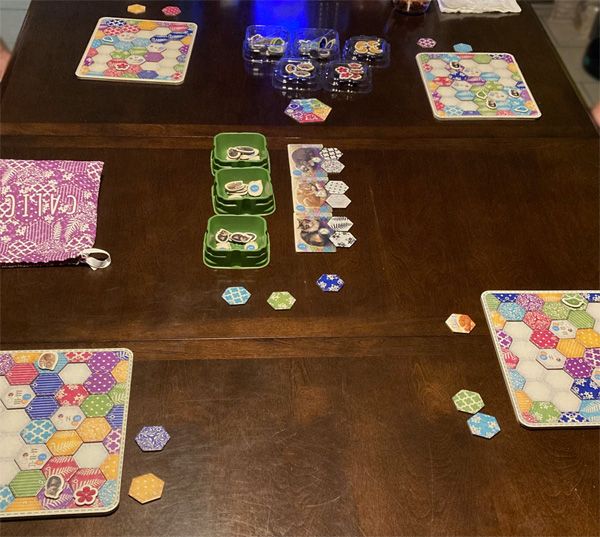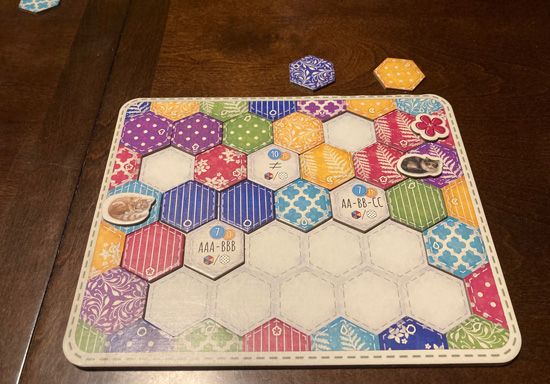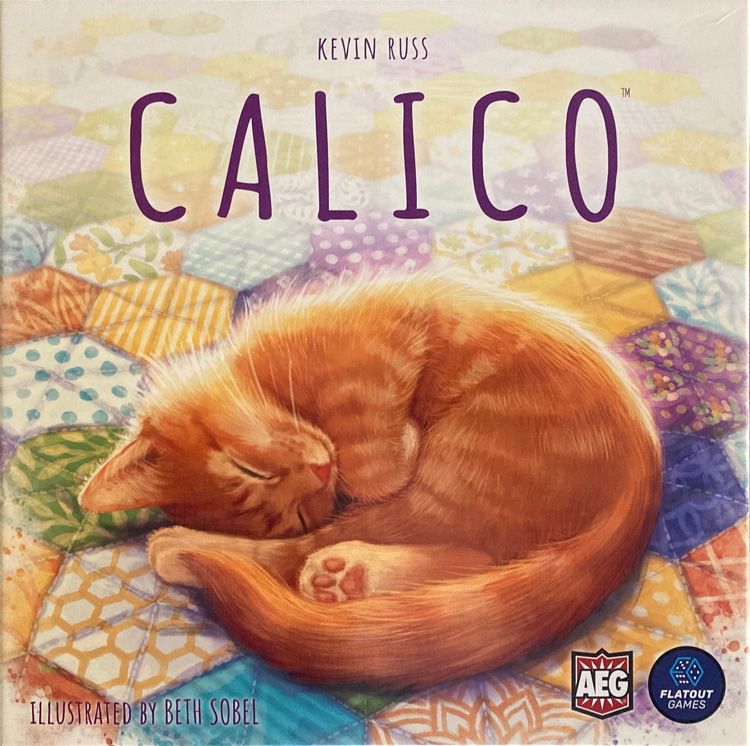Calico is a game published by AEG and Flatout Games. The premise of the game is for players to work to create the coziest quilt using patterns that will attract cats and allow them to sew buttons. The end of the game is triggered once all players have completely filled their quilt boards and the player with the most points is declared the winner.
This post is broken into the following 3 sections, feel free to jump directly to one:
- General summary - consisting of information about overall enjoyment, theme, replayability, and upgrades
- Complexity - consisting of information about the rulebook, setup, player turns, and overall learning curve
- Player turns - consisting of game type, game flow, rule you are likely to miss, and favorite aspect
General Summary
Number of players we had: 4
Our play time (not including setup): 1 hour 35 minutes
Overall enjoyment

Overall our group really enjoyed playing this game. We liked the theme and appreciated how much strategy was packed into this fun and fairly quick game. We also liked how easy it was to learn and begin playing though winning can be surprisingly hard.
One thing we really like about Calico is how the game can be as simple or as challenging as each player wants it to be. Not only are there different ways to set up the game, but there are variants for families, and in every game players can choose to try and fulfill design goals using colors or patterns or both colors and patterns, which is obviously more difficult.
This means this is a game that can be played with a diverse group of players and everyone can have fun playing even when they go about achieving goals differently. Calico is flexible enough to provide a great experience for all players and their abilities.
If we had to pick something that frustrated us it was that not all patch tiles get pulled out of the bag so it's possible a piece you need to complete a pattern might be impossible to get. Post playing, I think it is better that not all the tiles are available each game as it forces you to think more about your game play even though at the time, waiting for a specific piece to get pulled, can feel like torture.
Theme

Calico has an adorable cat and quilting theme based on real cats that are featured at the back of the rule book. The patch tiles and quilt boards have wonderfully vibrant colors and cute patterns. Each color-matched button is unique and the cat scoring tiles and cat tokens are cute. Overall the theme carries throughout all of the tokens, player boards and rule book and is appropriate for any game group and families.
Replayability

There are several things that increase the replayability of Calico, including:
- Each game players use only three of six randomly drawn and selected design goals.
- Design goals can be met using colors, patterns, or both, which provide different point values.
- During a game not all patch tiles are available.
- Only three of ten randomly selected cat scoring tiles are used each game.
- At the end of the rule book in the achievements section there are several changes to the rules you can implement into any game to change it up.
Upgrades
I am not aware of any upgrades for this game.
Complexity
Rule book
The rule book is well organized and easy to follow. There are multiple images showing how to set up a game, how scoring works, and explaining the different goals, etc. In addition to being easy to understand, there are several things about the rule book that show how much thought was put into it.
For example, there are two separate sections for setting up a game: a beginner setup and a standard setup. We all thought this was a great idea so new players can get started faster and then the game setup can become more challenging once the rules are better understood.
Also, towards the back of the rule book, there are several pages dedicated to tracking game achievements with your play group. This was such a cute idea! Not only do these achievements push you to push yourself, but they provide all kinds of new rules you can toss into a game to change it up and make it more challenging.
Lastly, it's a small detail, but every page of the rule book has a border that matches all the colors and patterns of the quilting tiles and it really does add a wonderful touch to the pages. All in all, we were really impressed with all the effort put into the rule book.
Setup
Calico takes about 15 minutes to set up. Players choose their quilting boards and choose from randomly drawn design goal tiles. Cat scoring tiles are selected for the game, cats and buttons are placed where everyone can see them, and all patch tiles are placed in the bag. Each player draws two starting tiles and then three random tiles become the tile market and you are ready to begin playing.

Turns
Calico consists of 22 rounds, but it goes fast. On your turn, players choose one of their two existing patch tiles and place it on their quilting board. If they meet the requirements for a cat scoring tile or button, they receive the corresponding cat or button and place them on their board.
Once this step is done, players select one of the three available patch tokens in the tile market, add a new random token to the market and then play passes to the next player. This process moves fast because while other players are taking their turns you are busy planning your turn. The only thing that slows you down is when someone takes a patch tile you were hoping to select and have to change up your plan.
Overall learning curve
The overall learning curve of this game is low though being successful is sort of a slow burn. One of the coolest parts about this game is that you can meet any of the three design goals on your player board using colors, patterns or both. Meeting both is much more challenging, but provides more points, so it is a risk that may or may not be worth it.
In addition to design goals, points can be gained by meeting a cat's design requirements and meeting the color requirements for buttons. Players can pick and choose which goals they think they can meet and how much they are willing to risk to get them.
Player Turns
Play type
Calico is a pattern building tile placement game that uses a hexagon grid. Players work to create specific patterns of hexagon patch tiles with the same color, same pattern, or both, to earn different types of goals. Each goal is worth a certain number of points at the end of the game and is based on complexity.
Throughout the game players are typically working towards several goals at once which is helpful when a desired tile takes several rounds to get. Towards the end of the game this can be more challenging, but since players can play on any open space, there is almost always something for players to work towards.

Game flow
The flow of this game is very fluid. Each player turn is composed of just two actions: placing an existing patch tile and determining if this meets any cat or button goals, then drawing a new patch tile. This means that while there are 22 rounds, they go quickly. Also, while other players take their turns you are busy determining your next play and planning so there is no lag time in this game.
Rule you are likely to forget/miss
There aren't an overwhelming number of rules in the game, but the one thing I forgot was that the two different point levels earned by meeting design tiles goals are color or pattern versus color and pattern. For some reason color versus pattern stuck in my brain which is wrong!
Favorite aspect
One of our favorite aspects about Calico is that it can be as strategic as you feel like making it. Sure you might not win if you are less strategic, but you will still enjoy playing the game and meeting the goals you focused on. For a smaller game, with only player boards, this game is easy to learn and delivers on strategy, fun, and a super cute theme.
Another thing we love about the game play is that the tiles surrounding the edge of each player board are actually part of your game! These can be used towards any of your goals so while they border the area where patch tiles are placed in the dual-cut board, these patch tiles act like played tiles rather than being just for looks. This is just another way Calico is a really well thought out game.
In summary, Calico is great when you feel like playing a game that has a decent amount of strategy but won't overwhelm players. Calico is also easy to learn and setup, does not require a large table, can be played with any player group, and has a fun theme! This is definitely a game that will be on our shelves for a long time and will be one we add to our "introduce to new game players" list.


